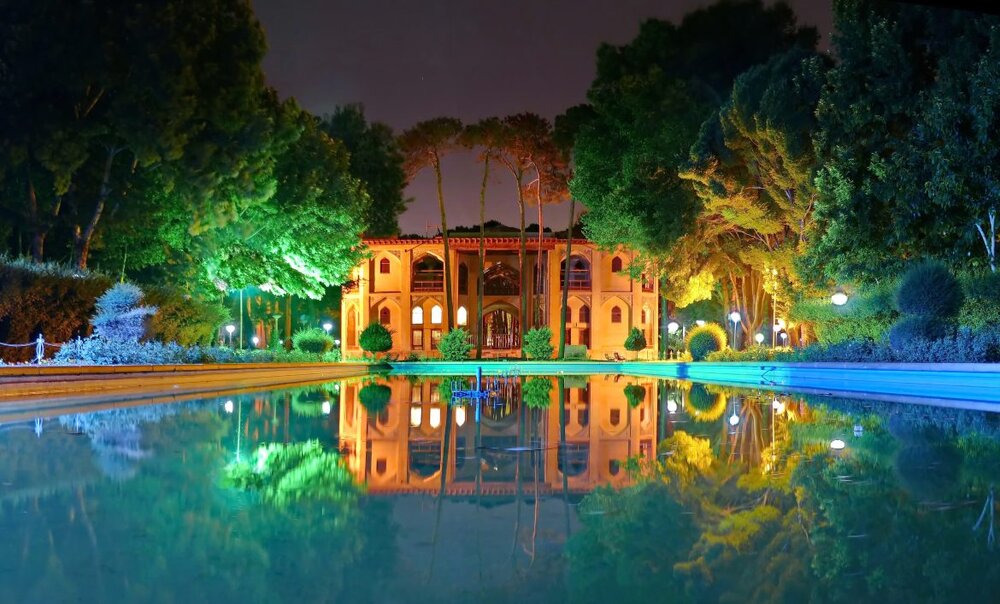Hasht Behesht Palace, a gateway to the paradise of color and art

Hasht Behesht Palace, meaning “Eight Paradises”, is literally a gateway to the paradise of color, art, light, and surprising beautifulness.
An exquisite Safavid-era (1501–1736) structure in Isfahan, central Iran, the palace bears intricate plasterwork, woodwork, and gorgeous murals even on the ceilings yet retain a domestic simplicity. The exterior tilework on the other hand is a source of charm for having a naturalistic style, depicting peacocks, trees, angels alongside other creatures.
What makes Hasht Behesht exceptional is the energy floating among the palace and the very heavenly garden surrounding it, which gives the visitors a feeling of suspension someplace between the rigidity of the earth and smoothness of skies.
The peace and silence that the garden offers along with the eye-catching murals and its unique architecture, cut people from the current stressful high-speed daily life and leaves no doubt that the structure couldn’t be named anything but paradise.
Hasht Behesht Palace was completed in 1669 as one of the forty-some mansions erected in Isfahan during the rule of Safavids, as Shah Abbas, the first king of the Safavid Empire, selected Isfahan as the capital city and decided to make it a competent city for his empire.
A long street, Chahar Bagh Street (the four gardens), was built and several gardens were developed in it. However, none of these gardens have remained except for Chehel Sotoun Garden and Hasht Behesht Garden. The beauty of the garden is not fully left for us to explore however the palace is still a lively monument. The brilliant architecture of the palace with its design and decoration has made it a legendary palace.
The two-story palace is built two meters above the ground level with four different façades each one visible through a particular angle. The walls of the first floor contain paintings and fascia architecture. The second floor exhibits some rooms, windows, and doors with cachet design. In the middle of the hall, there is a marble pool called “The Pearl Pool”. The design of the pool is in such a way that the water seeps through its holes like a pearl. This palace was a house to the eight wives of Shah Abbas. Four of them used to live on the first floor and the four others on the second floor. The artistic and glorious decorative design of the building has made the travelers speechless through all these years.
Despite its modest size, the palace has a rather complicated plan one has the feeling of coming into a labyrinth of interlinked rectangular and octagonal rooms. The ceiling that covers the main section in the building as well as the walls of the rooms is lined with colorful plasterwork and glamorous paintings.
Some say that in architecture Hasht Behesht refers to a specific type of floor plan common in Persian architecture, whereby the plan is divided into eight chambers surrounding the central room and each of these eight rooms represents eight levels of Paradise as Muslims believe.
In its heyday, the palace featured the most exquisite decorations: gilded mosaics and mirror-work, calligraphic friezes and brocade panels, marble slabs, and stucco moldings. But it is for its garden setting and the plaster ceilings cut into a variety of forms (similar to those in the Music Chamber of Ali Qapu) that the edifice is especially noted.
Soaked in a rich history and culture, Isfahan was once a crossroads of international trade and diplomacy in Iran. Now, it is one of Iran’s top tourist destinations for good reasons. The ancient city is filled with many architectural wonders such as unmatched Islamic buildings, bazaars, museums, Persian gardens, and tree-lined boulevards. It’s a city for walking, getting lost in its mazing bazaars, dozing in beautiful gardens, and meeting people.
The city has long been nicknamed Nesf-e-Jahan which is translated into “half the world”; meaning seeing it is relevant to see the whole world. In its heyday, it was also one of the largest cities in the region with a population of nearly one million.
ABU/MG
Leave a Comment